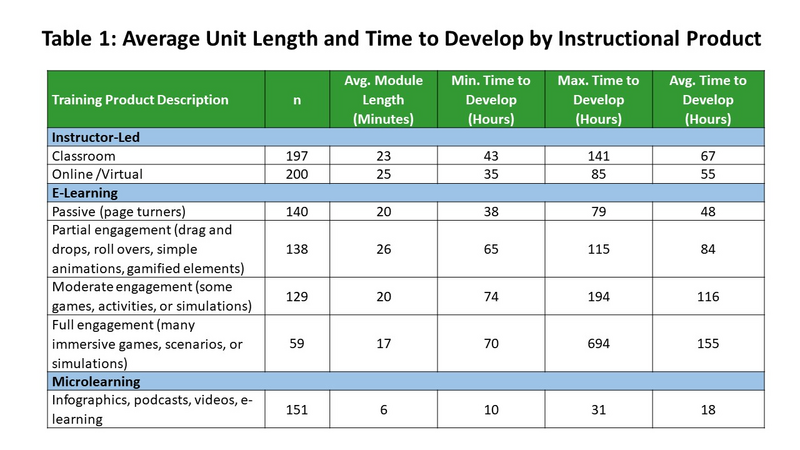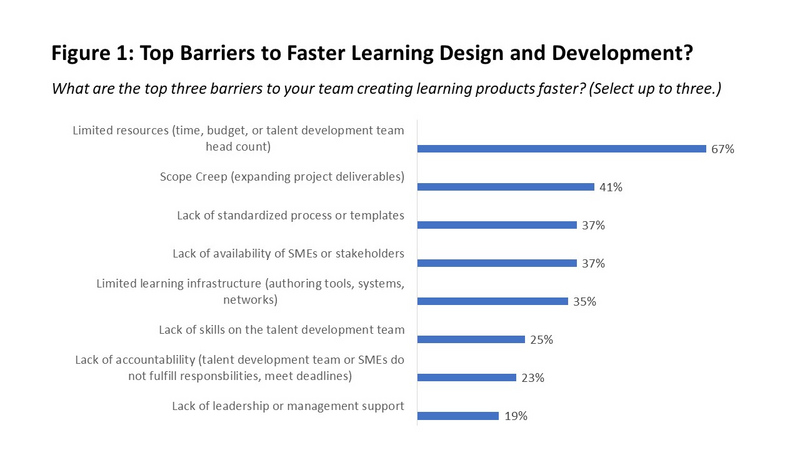ATD Blog
How Long Does It Take to Develop Training? New Question, New Answers
Wed Jan 13 2021

Bookmark
This post is a continuation of former research from 2003 to 2017 that sought to answer how long it takes to develop one hour of training.
Whenever we set out on a new project, one question we inevitably get is, “How long will it take?” This research supports you, the learning professional, as you continue to answer that question. It provides an update to the 2017 study on this topic to reflect talent development’s changing landscape.
The 2020 research has several key differences compared to the previous versions of the study, all with the purpose of making the results more relevant and actionable to us as practitioners. These include:
Reporting the time required to create units of training content rather than the time required to create an hour of content, as units of training content are rarely an hour long
Evaluating time to develop by training delivery method to reflect differences in development time across various training products
Segmenting the data based on job role, talent development reporting structure, and organization size
Considering which barriers have the greatest negative effect on training product production time
Due to these refinements, this research does not make historical comparisons to previous iterations of the study. I also caution you against making such comparisons and encourage you to use the data reported below to:
Develop internal data collection processes.
Benchmark this data against your currently used data for project estimations.
Support current and future project planning efforts.
About the Research
The target survey population for this research was learning development professionals from organizations of different sizes and industries. A link to the online survey, which consisted of seven questions, was distributed by email and social media in the fall of 2020.
The survey garnered 264 responses in total. Of these, 152 participants answered only the questions regarding the time to develop individual training products, and 112 participants answered all questions in the survey, including those related to their job role, their organization’s size and reporting structure for talent development, and their top barriers to creating learning products faster.
Among the 112 participants that completed the entire survey, 51 percent are learning development professionals reporting to a centralized management structure, whereas 49 percent are decentralized and report to separate business units.
Nearly half (44 percent) of respondents that answered all questions came from small organizations with 499 or fewer employees, 36 percent came from midsize organizations with between 500 and 9,999 employees, and the remaining 20 percent came from large organizations with 10,000 or more employees.
In terms of job responsibilities, a majority (65 percent) of participants who completed the entire survey identified themselves as all-in-one talent development professionals with wide-ranging responsibilities, which include needs assessment to learning design to training delivery. Around 11 percent identified themselves as talent development project managers, 9 percent identified themselves as instructional designers, 5 percent identified themselves as training developers, and 3 percent identified themselves as trainers. A small minority (7 percent) said their job responsibilities did not fit into any of these categories.
Development Time Findings
Does anyone design for an hour of training? Not really. The chart below shows how the 264 respondents identified which types of training products they develop and the minimum, maximum, and average times it took to create each. Participants were asked to calculate their time based on the work they perform for their current employer and on the ADDIE model, excluding summative evaluation. The average time to develop column is not a calculated average based on the minimum and maximum. It is the average time the respondent determined it takes them to create the selected training product.
Types of products ranged from instructor-led to varying levels of interactive e-learning to microlearning. Instructor-led (ILT) was divided into classroom and online, and e-learning was broken down into passive and levels of engagement—partial, moderate, and full.
Microlearning as defined by my co-author, Karl Kapp, and I in Microlearning: Short and Sweet is, “An instructional unit that provides a short engagement in an activity intentionally designed to elicit a specific outcome from the participant.” Examples given to participants were infographics, podcasts, video, and e-Learning. Those that chose microlearning were not asked to select the type of microlearning products they create.

Barriers to Faster Production
There are a multitude of reasons why respondents provided the development times they did. To that point, we wanted to know a bit more about what affects a respondent’s ability to produce learning products faster. Of the 264 responses, this is where we begin to focus in on the 112 fully completed surveys.

As shown in the chart above, we see that limited resources (time, talent, and money), cited by 67 percent of respondents, are the most frequently faced barriers to designing and developing learning content more quickly. After that, the percentage of respondents choosing each barrier fell dramatically. Scope creep (expanding project deliverables), lack of standardized processes or templates, lack of availability of SMEs and stakeholders, and limited learning infrastructure (authoring tools, systems, and networks) had a range of respondents between 34 and 39 percent.
More telling are the issues that respondents did not consider among their top barriers. More than 75 percent of respondents did not consider the capabilities (skills of talent development team) and accountability of their development and project teams (availability of SMEs and stakeholders) among their top challenges. Additionally, more than 80 percent of respondents appear to have less of a problem with leadership and management support compared to other barriers when it came to training production time.
Concluding Comments
Our field has been shaping itself for more than 75 years, and this question has been a vital one for the last 17 of them. Even though I don’t update this annually, I assure you the questions come to me monthly (I apologize if I have not responded. I do really try!) and those inquiries lend to adapting the survey.
However, the data will never be one-size-fits all. It is valuable because it gives you ways to baseline your organization and the desire to know how long your organization takes in creating a training product. It also provides us insight into common challenges and trends in our industry, no matter the size of the organization or the type of job role or product developed.
Of course, it lends to more questions once we start leveraging them to guide internal organizational discussion. That’s OK! I will ready my inbox and look forward to the discussion in the comments below.
More from ATD

